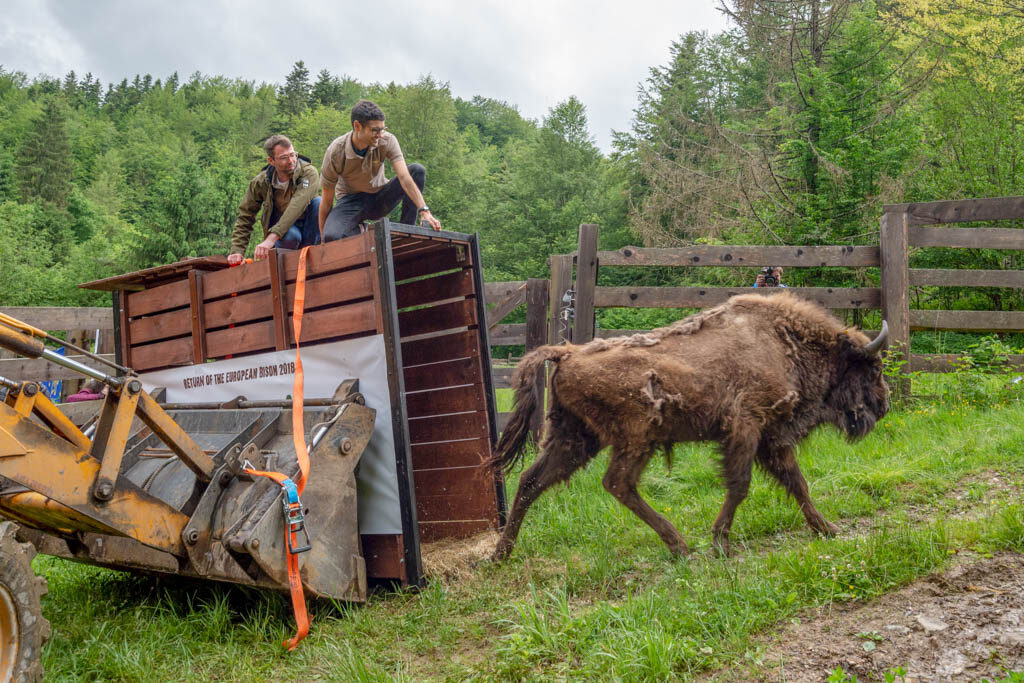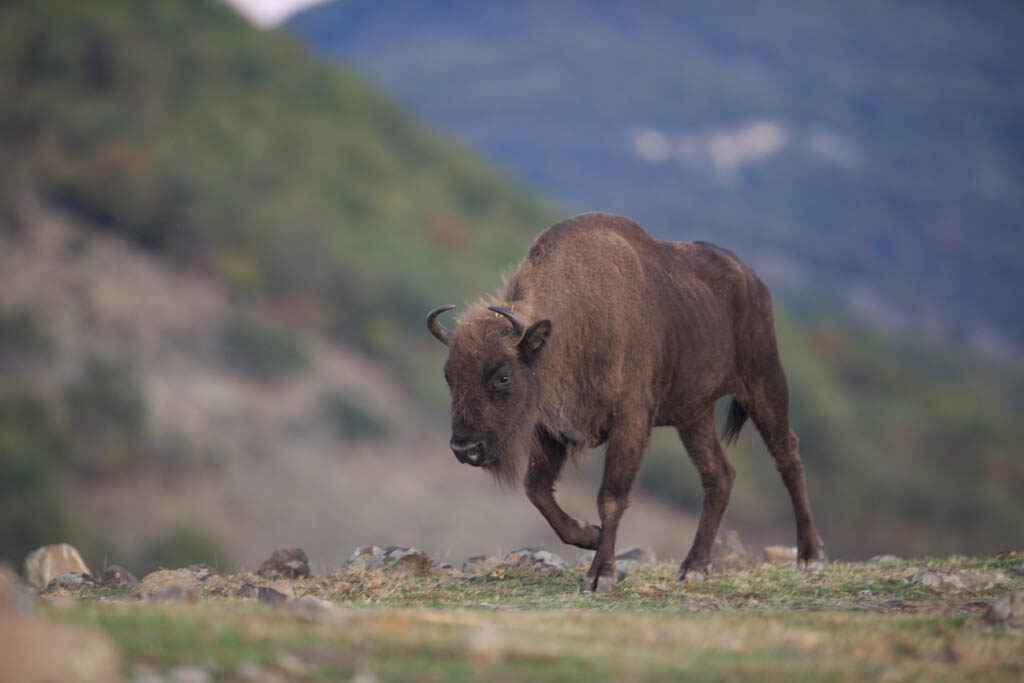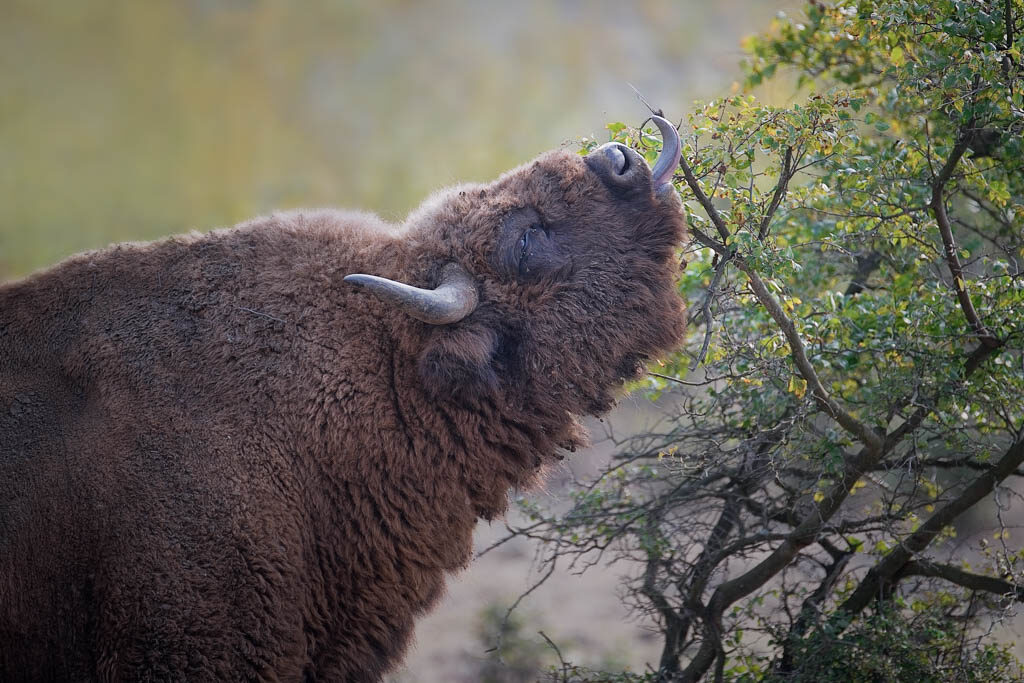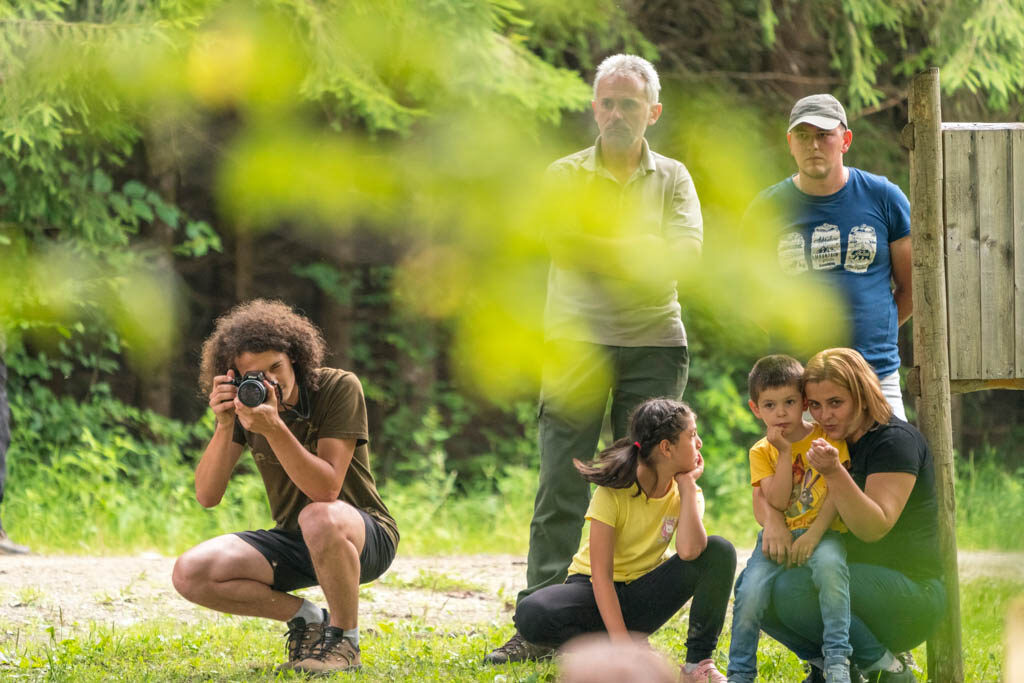







54
Nearly extinct in 1924, with only 54 animals left in European zoos.
7000
free-roaming individuals (in 2021).
850
Adult bulls weigh up to 850 kg.
12
founding animals so genetically still very vulnerable.
Many wildlife species have made a welcome return across Europe over the last four decades, helped by factors such as increased legal protection, reintroductions and other population support measures, corridor creation, and an ever greater willingness and desire by Europeans to live alongside wild animals. The comeback of the European bison, which dates back even further, happens to be one of Europe’s most heartening wildlife recovery stories.
With fully grown bulls occasionally tipping the scales at over 850 kg, the European bison is Europe’s largest living wild land mammal. It once roamed across the entire continent (except for parts of Spain, Italy and northern Scandinavia), but sustained hunting and habitat loss saw its range continually shrink across the centuries. When the last wild European bison was shot in the Caucasus in 1927, there were only 54 European bison left alive, all in captivity.
It is from this low point that the European bison has slowly but surely inched its way back, supported by various breeding programmes and reintroductions, with the first bison released back into the wild in Poland’s Białowieża Forest in 1954. Over the last 10 years the estimated number of free-roaming European bison has increased from 2579 to 7000 individuals, with the largest herds found in Belarus and Poland. Rewilding Europe’s own rewilding efforts mean over 100 European bison roam now free across the Southern Carpathians of Romania, while the Rhodope Mountains of Bulgaria have been home to a small but growing wild bison population since 2019 – the first time the animal has roamed free here since the Middle Ages.


Since 2004, most restoration efforts involving European bison have been guided and coordinated by a Bison Action Plan, produced by the IUCN’s Species Survival Group, in collaboration with the European Bison Conservation Centre (EBCC) and others. The main aim of the plan is to increase the size of European bison populations, preserve genetic variability, and enable free-ranging viable populations to function as a natural component of European ecosystems.
A milestone moment in the comeback of the European bison came in 2020, when the animal’s status was moved from “Vulnerable” to “Near Threatened” on the Red List of Threatened Species, which is produced by the International Union for Conservation of Nature (IUCN).
Despite the significant progress made over the last 10 years, the European bison still faces a number of challenges. These include an extremely small gene pool, hybridisation with American bison, health threats (new diseases and epidemics have been recorded), limited living space, isolation, poaching, and insufficient habitat for reintroduction. At present only eight free-living sub-populations are of viable size (150 animals), with most sub-populations remaining small and isolated.
A second Bison Action Plan, which will help to address many of these outstanding issues, is now under development by the IUCN and its Bison Species Specialist Group. Rewilding Europe’s own Bison Rewilding Plan will also be updated once this plan is released.
Europe is now at a turning point. For the first time in many centuries, people are leaving rural areas to seek new futures in cities and coastal areas. Coupled with this, a stronger legislative framework, dedicated species protection programmes, the development of a pan-European protected area network and growing public interest in wildlife are allowing many animals to naturally recolonise parts of their former range.
Against this backdrop – and despite the challenges involved in enabling its comeback – the future for the European bison looks encouraging. Once in danger of disappearing forever, this resilient species is now writing the next chapter in its ongoing history, as free-roaming populations continue to multiply and explore new landscapes, enhancing biodiversity and adding value to the lives of the people with whom they coexist.
100+
European bison now roaming free in the Southern Carpathians rewilding landscape.
38+
partner reservs established to source bison for translocation in the Southern Carpathians.
25+
calves born in the wild in the Southern Carpathians rewilding landscape since 2014.
1
reproduction centre established in Romania’s Hunedoara Zoo.
Bison rewilding in the Southern Carpathians of western Romania reached a milestone moment in 2021. Rewilding Europe and WWF Romania have been reintroducing European bison into the Southern Carpathians rewilding landscape, which is located close to the village of Armeniș, since 2014. The translocation of 26 bison here in 2021 took the total free-roaming population to more than 100 animals – the largest bison population in Romania.
Starting in 2014, the bison reintroduction programme in the Southern Carpathians has been supported by the European Union’s LIFE programme, through the five-year LIFE Bison initiative, as well as the Dutch Postcode Lottery. With the first phase of this reintroduction now coming to a close, the reintroduced bison will be allowed to breed naturally, creating a viable population that supports a thriving wild nature and local nature-based economy. A second phase of rewilding will then begin, with continued releases to further build the population to a minimum viable level (150 animals). This will also include the continued monitoring of the population, as well as efforts that enable local people to derive even greater benefit from bison presence.
The Carpathian Mountains were one of the European bison’s last strongholds in Romania before the species disappeared more than 200 years ago (mainly due to hunting and habitat loss). With more than 25 bison calves now born in the wild in the Southern Carpathians rewilding landscape, the reintroduced bison are clearly adapting well to their new home. GPS tracking has revealed that the animals have a current home range of over 90 square kilometres – when compared with data from herds in Poland and Germany, this is a good sign that the bison are making excellent progress recolonising the area.
The European bison is a keystone species, since it plays a distinct ecological role in shaping the landscape it inhabits. In addition to consuming great quantities of grasses and feeding on shrubs, bison influence the vegetation by de-barking trees, breaking open dense undergrowth (simply by walking right through it), and creating bare soil patches (by wallowing), which allows pioneer plants to move in. In addition, bison disperse nutrients (dung) and seeds across their territory (they scatter over 200 species of plants, which helps to increase floral biodiversity and supports pollinators). Breeding birds use bison winter fur as nesting material, and magpies follow the bison herd to pick off ticks and other parasites.
In the Southern Carpathians rewilding landscape, the reintroduced bison are already helping to create and maintain a half-wooded, half-open landscape, with the animals grazing excess vegetation from forest openings, meadows and forested meadows. As the diversity of the landscape and vegetation increases, so a range of habitats are created that are suitable for other grazers, small mammals, birds and invertebrates. In this way, bison conservation has wide-ranging ecological benefits for the entire region.
Over the last 10 years an ever-growing number of bison rewilding initiatives have become members of Rewilding Europe’s European Rewilding Network. This has helped to enhance the impact of rewilding by enabling the exchange of experience and expertise.
89%
of the of the Armeniș and Densus communities in the Southern Carpathians consider the bison beautiful and important animals for the environment.
50
meters minimal safe distance when viewing bison in the wild.
100+
students at 5 primary schools involved in workshops and classes linked to reintroduced bison and wild nature in the Southern Carpathians since 2016.
13
European Rewilding Network members now host European bison.
Much like the North American bison, European bison have been important to human culture for millennia, featuring in the cave art of pre-historic people as far back as 20,000 years ago. Over the last 10 years, as these mighty beasts have returned to an ever-growing number of European landscapes, they have captured people’s hearts and minds on a burgeoning scale.
Rewilding Europe and WWF Romania have been reintroducing bison in the Southern Carpathians of Romania since 2014, with over 100 animals now roaming free in the Țarcu Mountains. The returning animals have quickly become an important part of local culture and a source of pride for communities in the area.
“Romanians have always been attracted by the greatness of bison, which feature heavily in Romanian legends and folklore,” says Bianca Stefanut, a communications officer with the Southern Carpathians rewilding team. “Thanks to the comeback of this mighty animal, Romanians are increasingly proud of the richness of nature that surrounds them.”
The short film “Zimbrul”, shot by award-winning French filmmaker Emmanuel Rondeau in 2019, is an intimate snapshot of people’s feelings about the return of European bison in the Southern Carpathians. Portraying the acceptance of bison by people in the area, and their changing perceptions of wild nature, the film demonstrates why the positive involvement of local communities is so critical to the success of rewilding efforts.
“For me, the best moments during shooting were meeting people in the rewilding landscape and feeling their strong connection with the environment,” says Rondeau. “Some people will always be passionate about nature. But I think the most interesting thing is that the return of the bison triggered something in people who’d never cared about nature before. In many communities, the comeback of bison has placed nature back in the centre of the discussion.”
“In many communities, the comeback of bison has placed nature back in the centre of the discussion.”
The positive social and cultural impact of the bison reintroduced to the Southern Carpathians was confirmed in a recent sociological study, conducted as part of the LIFE Bison initiative. In the village of Armeniș, the vast majority of the local community perceived the animals to be beautiful, worthy of protection and suitable for the local landscape.
“The bison represents the grandeur and beauty of nature in the Southern Carpathians,” says Orieta Hulea, director of WWF Romania. “The charisma of this legendary animal has resonated within local communities and helped to generate feelings of pride and ownership, as well as an appreciation of the overall reintroduction programme. As the free-roaming herds continue to multiply over the next 10 years, this impact will surely grow.”
“The bison represents the grandeur and beauty of nature in the Southern Carpathians. The charisma of this legendary animal has resonated within local communities and helped to generate feelings of pride and ownership.”
1
nature observatory constructed and 2 hamlets restored in the Southern Carpathians rewilding landscape.
4
bison rangers trained up and 1 local intervention team established in the Southern Carpathians.
100
families are now involved in bison tracking activities in the Southern Carpathians.
58
European bison in the European Rewilding Bank in 2021.
Rewilding isn’t just about restoring landscapes and reintroducing missing species. Ensuring people can earn a fair living from the wild is critical to the success of rewilding projects, helping to generate support and maintain harmonious relations between humans and wildlife.
Over the last 10 years, the number of European bison roaming free across Europe has increased from just over 2500 to 7000 individuals. This trend is reflected in Rewilding Europe’s European Rewilding Network, which now includes 13 members engaged in bison reintroduction programmes, distributed right across Europe.
As the mighty bison – Europe’s largest living land mammal – continues to make a comeback, it is understandably drawing growing numbers of tourists and wildlife enthusiasts. This, in turn, is helping to drive the development of nature-based businesses and economies in and around bison rewilding landscapes.


In the Southern Carpathians of Romania, Rewilding Europe and WWF Romania have been reintroducing European bison since 2014, with free-roaming herds now totalling over 100 individuals. These animals are not only helping to create biodiversity-rich mosaic landscapes and enhance local food webs, but are also supporting the development of a thriving nature-based economy.
More than 100 tourists visited the bison rewilding site in the Southern Carpathians between 2016 and 2020. Rewilding Europe’s Wilder Places offers bison tracking experiences in the Southern Carpathians of Romania, with an estimated 100 local families now involved in the provision of related services.
In addition to this, the bison reintroduction programme has seen four bison ranger positions created (which are all filled by local Romanians). A refurbished visitor centre in the village of Armeniş now sells locally produced handicrafts and souvenirs, while a refurbished wilderness cabin near Armeniş opened in 2017. Another cabin, two wildlife hides and a larger “hillock retreat”, located in the nearby village of Plopu, are all under development. These will underpin further economic growth once complete.
In a recent sociological study, conducted as part of the LIFE Bison initiative, more than half of participants in the village of Armeniş considered reintroduced bison to be a source of economic revenue or a source of local jobs, while nearly three-quarters thought that the animals were attracting more tourists to the area. This is especially important in a village such as Armeniş, which has long been affected by rural depopulation.
The wildlife-watching industry is now growing exponentially across the world, with people in Europe and beyond seeking connections with nature that are memorable and unique. European demand for tailor-made wildlife-watching trips, in particular, has increased over the last decade. This trend is likely to continue, underpinned by a growing awareness of the climate emergency and the need to focus on more nature-friendly travel.
This bodes well for rewilding-related tourism. As the number of bison rewilding initiatives continues to multiply over the coming decade, so the economic impact of these charismatic animals will surely grow too.